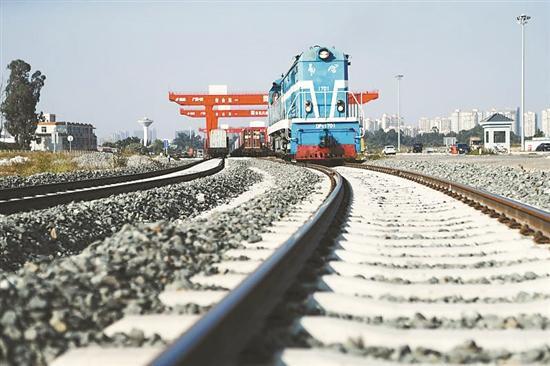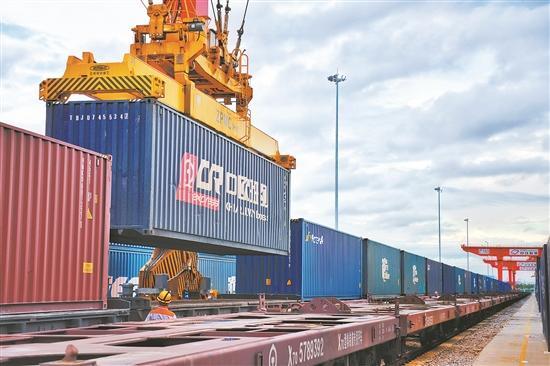
Nowadays, European people can enjoy affordable and high-quality home appliances "made in Greater Bay Area", while people in the GBA can savor delicious and sweet mangosteens and durians from other countries. The circulation of domestic and foreign goods is supported by the transportation of international freight trains such as the China-Europe freight train and China-Central Asia freight train.
This year marks the 10th anniversary of the Belt and Road Initiative. Over the past ten years, the Pearl River Delta region in Guangdong has successively launched multiple international freight train routes such as the China-Europe freight train, China-Central Asia freight train and China-Africa Rail-Sea Express Train. These freight trains not only bring high-quality light industrial products from Guangdong to countries and regions along the Belt and Road, but also transport their local specialities and fresh fruits back to Guangdong, benefiting people in the province with the convenience of buying globally without leaving home.
In ancient times, there was a "commercial camel fleet" on the Silk Road, and now there are "steel camel fleets" like the China-Europe and China-Central Asia freight trains. Both freight trains, organized by China State Railway Group Co., Ltd., are international intermodal trains connecting China and Europe, as well as countries and regions along the Belt and Road. Compared with shipping and air transportation, freight trains have lower costs than air transportation and faster speed than shipping, with advantages such as safety and real-time monitoring.

At 5 am on July 4th, the first China-Kyrgyzstan-Uzbekistan international multimodal cargo train departed smoothly from the Port of Guangzhou, marking the 18th international train channel in the Guangdong-Hong Kong-Macao Greater Bay Area. Data shows that in 2022, a total of 650 China-Europe freight trains departed from the Greater Bay Area, transporting 63,942 standard containers of goods, over 416,000 tons of necessities and anti-epidemic materials throughout the year 2022. The number of trains operated has been increasing year by year, reaching a historical high for seven consecutive years.
A series of return trains of the China-Europe and China-Central Asia freight trains bring numerous production materials and local specialities back to Guangdong. On March 12th of 2023, the return train from Europe with 102 standard containers transported 1,275 tons of corrugated paper and other goods for import and export enterprises in the Greater Bay Area; On April 24th, the first international refrigerated freight train (numbered 45113) to return via the China-Laos Railway, carried 414 tons of durian from Thailand's Map Ta Phut station to Guangzhou's Zengcheng West Railway Station.
In recent years, in addition to the increasing density of train routes and the continuous expansion of transportation channels, the types of import and export products carried by the China-Europe and China-Central Asia freight train in the Greater Bay Area have been continuously enriched. The goods not only include the initial household appliances, clothing, shoes, hats, and daily necessities but also consist of categories including electronic equipment, mechanical equipment, and new energy products, which are up to more than a thousand kinds.
What's more, the structure of export commodities on the freight trains is also continuously optimized. While traditional commodities such as household appliances, clothing, and shoes keep their rapid growth, the export of high-value-added products such as electronic equipment, mechanical equipment, and new energy vehicles has also increased significantly.
Data shows that in 2022, Guangdong's total import and export volume with countries and regions along the Belt and Road reached 2.25 trillion yuan with a year-on-year increase of 10.3%. Guangdong has become the province with the largest trade volume and the most bilateral investment with countries and regions along the Belt and Road in China.
国际班列助力广东“买全球”“卖全球”
欧洲人民用上物美价廉的“湾区造”家电,粤港澳大湾区人民吃上香甜可口的山竹、榴莲……国货与洋货双向流通的背后,离不开中欧、中亚等国际班列提供的运力支持。
今年是“一带一路”倡议提出10周年。10年间,广东珠三角地区先后开通中欧、中亚、中非等多条国际班列线路,更多“一带一路”沿线国家和地区的人民用上了来自广东的优质轻工产品;广东人民也更容易买到沿线国家和地区的特色产品和新鲜水果,实现不出门便可轻松“买全球”。
古有丝绸之路“商贸驼队”,今有中欧(亚)班列“钢铁驼队”。中欧(亚)班列是由中国国家铁路集团有限公司统一组织,运行于中国与欧洲以及“一带一路”沿线国家和地区间的铁路国际联运列车,被誉为“钢铁驼队”。与海运和空运相比,中欧(亚)班列成本比空运低,时效比海运强,还具备安全可靠和实时追踪等优势。
7月4日凌晨5时,首列“中吉乌”多式联运国际班列从广州国际港顺利驶出,标志着粤港澳大湾区国际班列通道已达18条。数据显示,2022年,粤港澳大湾区全年开行中欧班列650趟,发送货物63942标箱,累计运送生产生活和防疫物资逾41.6万吨,开行数量逐年递增,已连续7年创历史新高。
通过一列列中欧(亚)回程班列,众多生产物资和当地特产进入广东。今年3月12日,满载着102个标准集装箱的中欧回程班列为粤港澳大湾区进出口企业带回1275吨的瓦楞纸等货物;4月24日,首趟经过中老(泰)铁路返程的45113次国际冷藏货运班列,满载414吨榴莲,从泰国玛达普站发出,经过中老铁路,运至广州增城西铁路货场……
近年来,除了线路越织越密、运输通道不断扩宽外,粤港澳大湾区中欧(亚)班列进出口产品品类不断丰富,已从最初的家用电器、服饰鞋帽和日用百货等,逐步发展为包括电子设备、机械设备、新能源产品在内的逾千种品类。班列出口商品结构也在不断优化,除了家用电器、服饰鞋帽等传统商品保持较高增长水平外,电子设备、机械设备、新能源汽车等高附加值产品出口也明显增加。
数据显示,2022年,广东与“一带一路”沿线国家和地区进出口总额高达2.25万亿元,同比增长10.3%,已成为中国与“一带一路”沿线国家和地区贸易量最大、双向投资最多的省份。
文|羊城晚报全媒体记者 李志文
翻译|白心怡
责编|王瑜瑛









